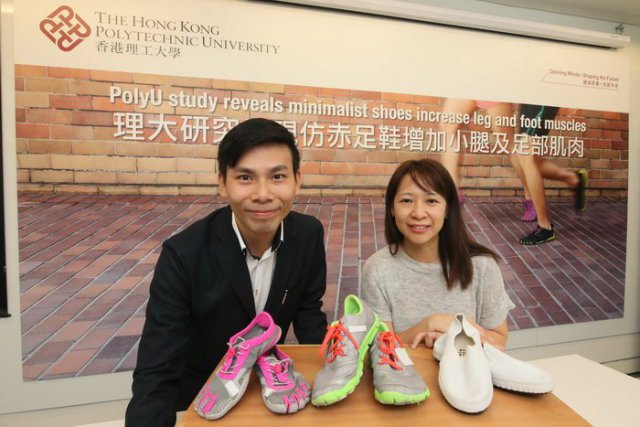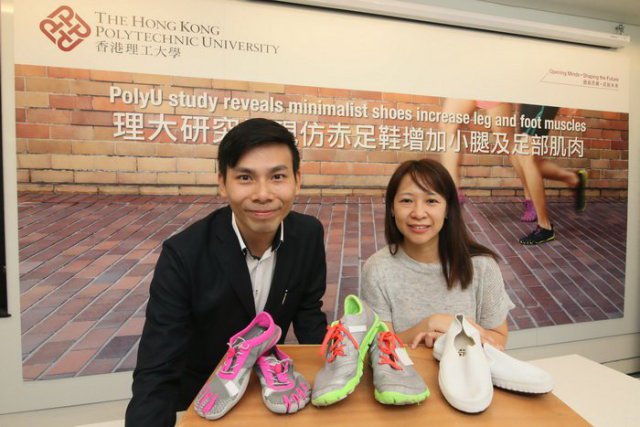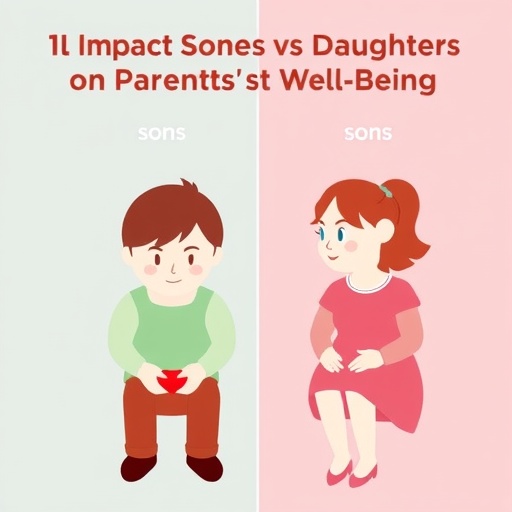In a recent study conducted by The Hong Kong Polytechnic University (PolyU) and the Harvard Medical School, running in minimalist shoes can increase leg and foot muscle volume, indicating its potential application in rehabilitation programme.

Credit: Image courtesy of Hong Kong Polytechnic University
Dr Roy Cheung, Assistant Professor in PolyU’s Department of Rehabilitation Sciences, together with his team, recruited 38 runners, with a mean age of 35, from local running clubs. The participants, comprising 21 males and 17 females, have been running for six years on average with their traditional running shoes (TRS), footwear of heel-to-toe drop over 5mm, with additional cushioning pad and artificial arch support.
Among the 38 participants, 20 runners selected randomly to the experimental group underwent a six-month training programme. At the beginning, each participant was given a pair of minimalist running shoes (MRS) and a self-monitoring programme including transition exercise regimes such as calf strengthening exercise and balance training. The MRS used in this study featured an open-topped upper made of stretchy fabric, five separate toe compartments, zero heel-to-toe drop, no midsole cushioning or arch support, and a uniform 3-mm outer sole. The other 18 runners in the control group received the same training programme running with their own TRS.
All the participants were invited to undergo a magnetic resonance imaging (MRI) scanning for measuring their right leg and foot muscles before and after six-month intervention. The experimental group exhibited significantly greater leg and foot. The mean volume of the extrinsic foot muscles (EFM) attached from the leg to foot increased from around 25,100 mm 3/kg to around 27,000 mm 3/kg, an increase of 7.05%, and the intrinsic foot muscles (IFM) attached from the heel to toes increased from around 4,600 mm 3/kg to near 5,000 mm 3/kg, an increase of 8.8%.
When grouping muscles into the forefoot and rearfoot regions, in the experimental group, the foot muscle growth was mainly contributed by the forefoot muscle rather than the rearfoot muscle. The mean volume of the forefoot and rearfoot increased by 11.9% and 6.6% respectively. In contrast, the volume of leg and foot muscles in the control group remained unchanged.
The study also found a positive correlation between participants’ MRS compliance and the changes in leg muscle volume. The more compliant participants are in wearing MRS, the higher the leg muscle volume growth.
The research team explained that as MRS provides minimal cushioning and no mechanical support to the foot arches, the IFM and EFM, which function as important foot arch stabilisers, would experience greater demands for strength. The volumetric growth of EFM may also be due to higher strain and greater force generation in the posterior and medial calf muscles when running with MRS.
In addition, mid/forefoot landing imposed more stimuli to the anterior part of the foot, especially for the metatarsophalangeal joint, the joint of the foot and toes. Muscles responsible for metatarsophalangeal joint motions may therefore be strengthened with this type of landing.
The study showed the transition to MRS strengthened the muscular components of the foot core system, indicating its potential application in rehabilitation program. Instead of focusing on foot orthotic device, foot core training should be emphasised in current clinical guidelines in treating injury related to weak foot muscles.
Web Source: Hong Kong Polytechnic University.
The post Minimalist shoes increase leg and foot muscles appeared first on Scienmag.





